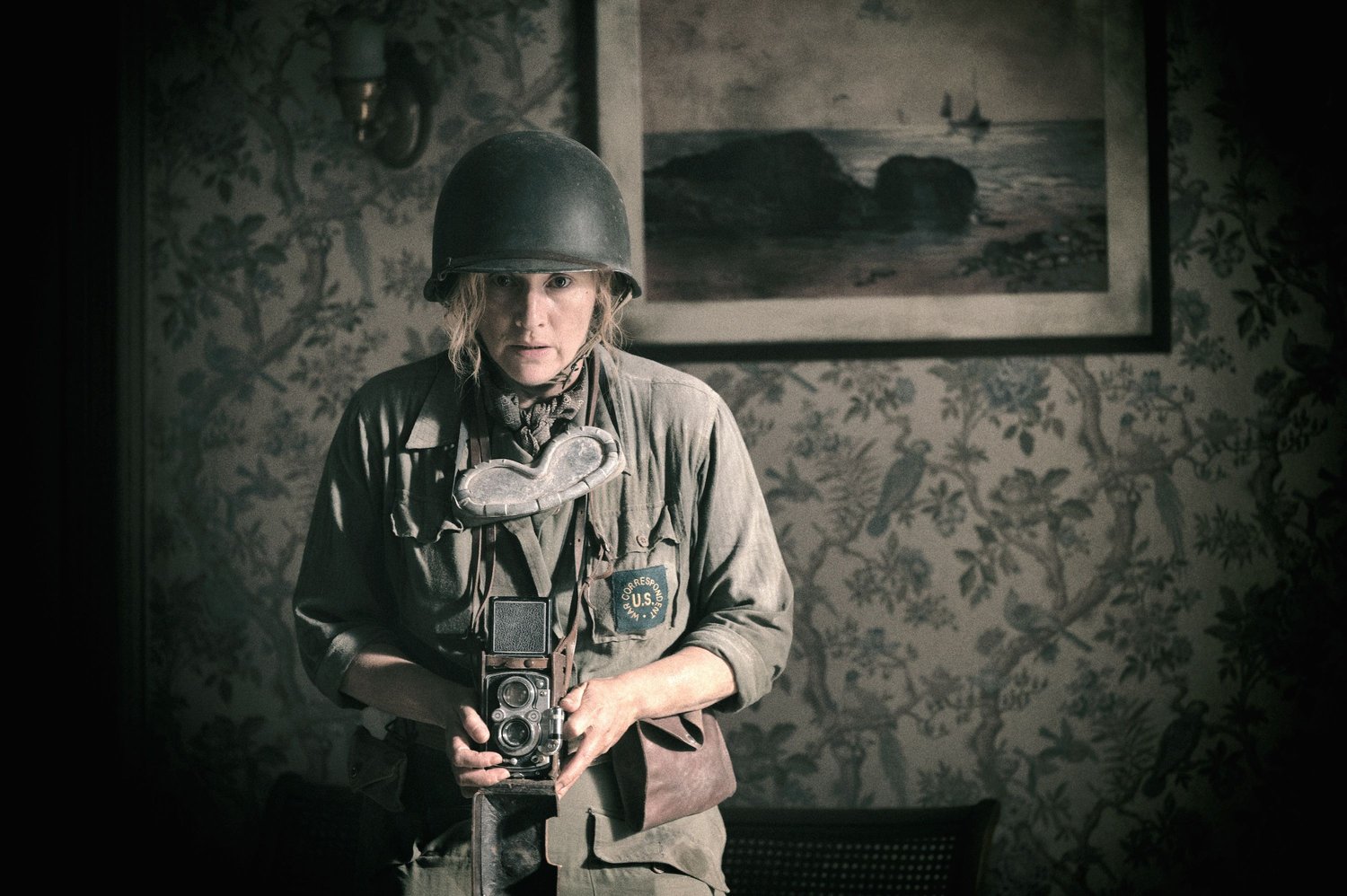Images by Kimberly French for Roadside Attractions
LEE– 3 STARS
Long-time cinematographer Ellen Kuras’ directorial debut Lee– adapted from Antony Penrose’s 1985 biography The Lives of Lee Miller of his own mother– highlights photographer and photojournalist Lee Miller. Notice the plurality of the biography’s title and how it could be construed in different ways by a potential audience. A dark inference could lead to a case study of dissociative identity order. Rest assured right away, it’s not that kind of movie. Rather, the sunnier estimate takes the “lives” part to mean the woman’s numerous career paths. A more astute gauge would focus on the photography angle and define “lives” to be the many subjects captured by her lens and film.
Those latter two paths are fittingly commemorated by Lee to reveal one of the more outgoing and remarkable individuals of the “Greatest Generation” of the 20th century. Before World War II, Lee Miller was first a prominent fashion model in the 1920s before becoming an accomplished and published photographer in her own right. Professionally and socially Lee lived and worked many years overseas in Europe where she rubbed elbows and indulged in the carefree lifestyle of the Surrealist cultural movement. Lee enters Miller’s history at the tail end of that time period in 1938, where she is played in every era seen by the determined Academy Award winner Kate Winslet.
Soon after meeting and falling in love with the English artist and poet Roland Penrose (the ever-swoony-worthy Alexander Skarsgård of The Northman) in the Mougins region of France, the arrival of Hitler’s regime splintered Lee’s circle of artists–which included French Vogue fashion editor Solange d’Ayen (fellow Oscar winner Marion Cotillard) and the married couple Paul and Nusch Éluard (Vincent Colombe and The Portrait of a Lady on Fire breakout Noémie Merlant)– into hiding and Resistence work. Back in London with Roland during the Blitz, Lee successfully pitched London Vogue editor Audrey Withers (recent Oscar nominee Andrea Riseborough) to become a war correspondent and photojournalist.
After initially canvasing the arrival and departure bases in England and having her access to the active battlefields blocked by gender and military rank rules of the time, the resolute Lee proved her mettle and was eventually paired with Life magazine war correspondent David Scherman (the second-billed Andy Samberg). The two would embark on excursions deeper and deeper into the European Theater with coverage of the liberation of the Buchenwald and Dachau concentration camps and Hitler’s famed Munich apartment the day he killed himself in Berlin.
LESSON #1: WHAT WAR CORRESPONDENTS SHOW– Lee impressively recreates the methods and routines of Miller and Scherman working in a guerilla-style environment with steady communication, little supervision, and period equipment, Shot with a cinematographer’s eye in the director’s chair, the film knows to celebrate the daring work of war correspondents and frontline photojournalists. Like the immortal photographs themselves, Lee unflichingly recreates the conditions, violence, resilience, bravery, and shame on display in front of the shutters of courageous characters who would rather take a picture than be one. The horrors of World War II resonate strongly, even in fictionalized form.
LESSON #2: WHAT WAR CORRESPONDENTS SEE– That said, there’s another layer in Lee. Taking the perspective of the voyeuristic observer, Lee also exposes what war correspondents saw beyond the edges of the developed photographs or in the moments of time before or after the still shot of the circumstances you cannot initially see. Every dead body is, in essence, a voice victim Lee becomes the story behind the pictures and why they matter over simply the question of whether they should be seen or published for the public to see. The film powerfully reminds you there are people who took the pictures you’re pouring over, complete with their own bravery, resilence, and shame to be in those settings and moments.
LESSON #3: CREATING EMPATHY THROUGH IMAGES– What the work of photojournalists like Lee Miller and David Scherman showed and what they saw to capture their images was critcially important and remains so to this day because of the empathy generated. Their work went where regular citizens couldn’t go. Moreover, their primary source-level stories let the general public know what was going on during dangerous times, and those informed sentiments from readers and followers ignited the masses. Lee Miller pushed empathy further as her own artist. There’s a great exchange in Lee when a superior compliments that” only a woman could have taken these” when it comes to some of the striking images she did.
Lee is at its most impactful during Miller and Scherman’s suspenseful journeys during the World War II portions of the overall narrative. When the film is away or leaves those harrowing memories and settings, it looses a little bit of the grit and edge. A prime culprit of that is a framing device employed by the movie’s three screenwriters– Liz Hannah of The Post, John Collee of Master and Commander: The Far Side of the World, and Marion Hume of Vogue Australia. Set in 1977 at Lee Miller’s Farley Farm House homestead (which is now the home to a museum honoring her and Roland’s art and lives), red-hot Challengers star and The Crown Emmy winner Josh O’Connor plays Lee’s question-asking son Antony discovering box upon box of his mother’s unreleased and unheralded work while Winslet redirects the flow as a narrator in aging makeup.
Removing that shell would create an heightened illusion in the survival department for those who do not know the Lee Miller story in advance. In a similar regard to O’Connor, the very overqualified talents of Marion Cotillard and Noémie Merlant are not give much to do as female confidantes. Those two historical figures have their own history worth telling or weaving, but that would take the prestige mini-series approach and not a two-hour film. Like the scenes in 1977, some of those lush segments could be briefer flashbacks or could be gladly traded altogether for more time in the thick of the fray where the heart of the story resides.
Matching the shared praise shown within the journalism realm from that heart, there’s an automatic level of respect demanded and earned by Kate Winslet. Her clout as an actress equals her commitment to the difficulty of this role in Lee. Knocking on the door of 50 years old, Winslet nevers wastes a scene of this plum opportunity. The very same can be said of the moral foil and intrepid shadow portrayed by Andy Samberg as Scherman. The frequent funnyman capably uncorks his first dramatic film role with absolute reverence for the true and vigilant representation his character involves and embodies. Get that man more parts like this to show his fuller possible range as an actor.
LOGO DESIGNED BY MEENTS ILLUSTRATED (#1233)



